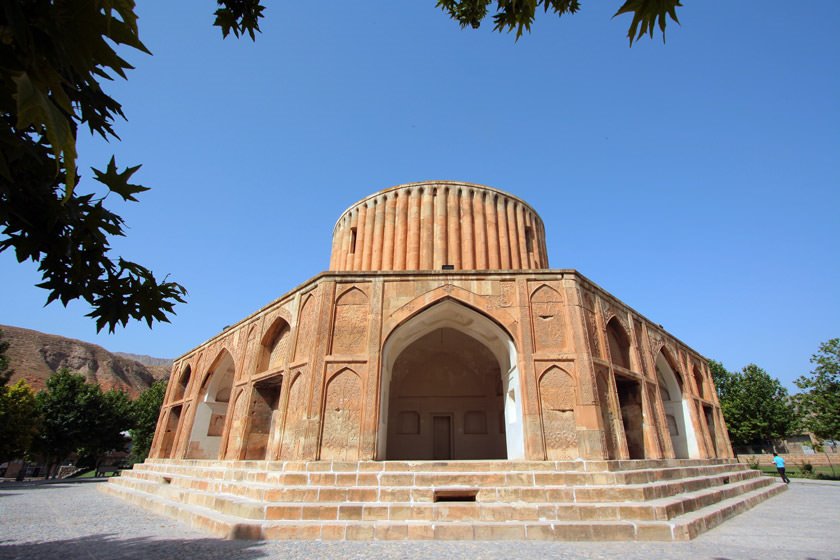Chaharshanbe Souri: One of Iran’s Ancient Celebrations
Charshanbe Suri, a lively and joyous celebration, takes place on the eve of the last Wednesday of the solar year, serving as a prelude to welcoming the New Year.
Charshanbe Suri is one of the traditional Iranian festivities held at the sunset of the last Tuesday of the solar year, just before the arrival of Nowruz. It encompasses various customs, from lighting bonfires and fireworks to consuming problem-solving snacks, family gatherings, spoon-banging, and more, some of which have faded into oblivion.
Charshanbe Suri is among the most vibrant preliminary rituals of Nowruz in various parts of Iran, with fire being its central element, as reflected in its name derived from fiery flames. However, the use of flammable and explosive materials in modern times has turned this celebration into a risky ceremony, resulting in physical injuries and even fatalities. This event is not tied to any specific religion or ethnicity, as participants range from Muslims to Zoroastrians, Christians, and beyond, passing the tradition from one generation to another. Similar festivities are also observed in other countries, such as the Republic of Azerbaijan, Afghanistan, Turkey, and by Iranians residing abroad. For a more in-depth understanding of Charshanbe Suri, join us in exploring its history and customs in this article.
Everything you need to know about Charshanbe Suri:
What is Charshanbe Suri?
Which day is Charshanbe Suri?
History of Charshanbe Suri
Charshanbe Suri in Shahnameh
Philosophy of Charshanbe Suri
Customs and traditions of Charshanbe Suri
Charshanbe Suri in different regions of Iran
Foods and snacks on Charshanbe Suri
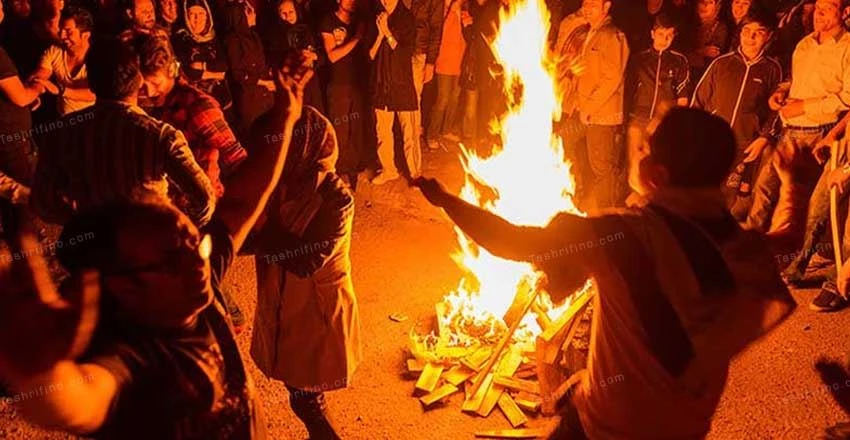
Charshanbe Suri, What Is It?
Charshanbe Suri is one of the Iranian celebrations held with specific customs on the eve of the last Wednesday of the year. Some researchers consider the word “Suri” to mean “celebration,” while others believe it is derived from the Pahlavi word “Sourik,” meaning “red,” symbolizing the redness of fire or the individual’s health. The pronunciation “Charshambe-Soori” in Isfahan may support this claim.
This celebration is known by various names in different regions of Iran, such as “Gol-Goleh Charshanbe” (Gilan), “Chwareshmeh Kuleh” (Kurdistan), “Charshambe-Soori” (Isfahan), “Kuleh Charshanbe” (Qazvin), and more. Despite their commonalities, each region conducts Charshanbe Suri with its unique customs.
What Day is Charshanbe Suri?
Contrary to its name, Charshanbe Suri starts from the evening of the last Tuesday of the year and continues into the night. Charshanbe Suri in the year 1401 coincides with Tuesday, March 24.
History of Charshanbe Suri
Since Iranians, before Islam, did not have named days or weeks and did not engage in jumping over fire, which contradicts Zoroastrian rituals, some argue that Charshanbe Suri cannot be considered a celebration from the pre-Islamic era.
Regarding the connection of Charshanbe Suri with Zoroastrianism, Katooyun Mazdapoor, a Zoroastrian researcher and author, mentioned:
“Iranian celebrations and rituals belong to all Iranians. Many of them date back to the pre-Aryan migration era to this land, and many of them have never been Zoroastrian, like Charshanbe Suri.”
However, the oldest source referencing Charshanbe Suri is the book “Tarikh-e-Bukhara” by Abu Bakr Muhammad ibn Ja’far Narshakhi, stating:
“When Amir Mansour ibn Nuh settled in Moulian, in the month of Shawwal in the year 350, he ordered the reconstruction of that palace, and everything that had been ruined or lost was better than before. At that time, while the year was not yet complete, on the night of Suri, as was the ‘old custom,’ a great fire was lit.”
It seems that there is no mention of Charshanbe Suri in ancient texts, especially before Islam, leading to the claim that this celebration became prevalent in Iran after the Islamic era. One reason for this is its occurrence on the last Wednesday night of the year. According to the lunar calendar, Wednesday starts from the sunset of Tuesday.
Moreover, Arabs considered Wednesday an unlucky day, avoiding it for weddings, travel, etc. As Manuchehri Damghani said:
“When Wednesday, the day of calamity, comes, drink wine. Drink Satkin wine for a smooth passage.”
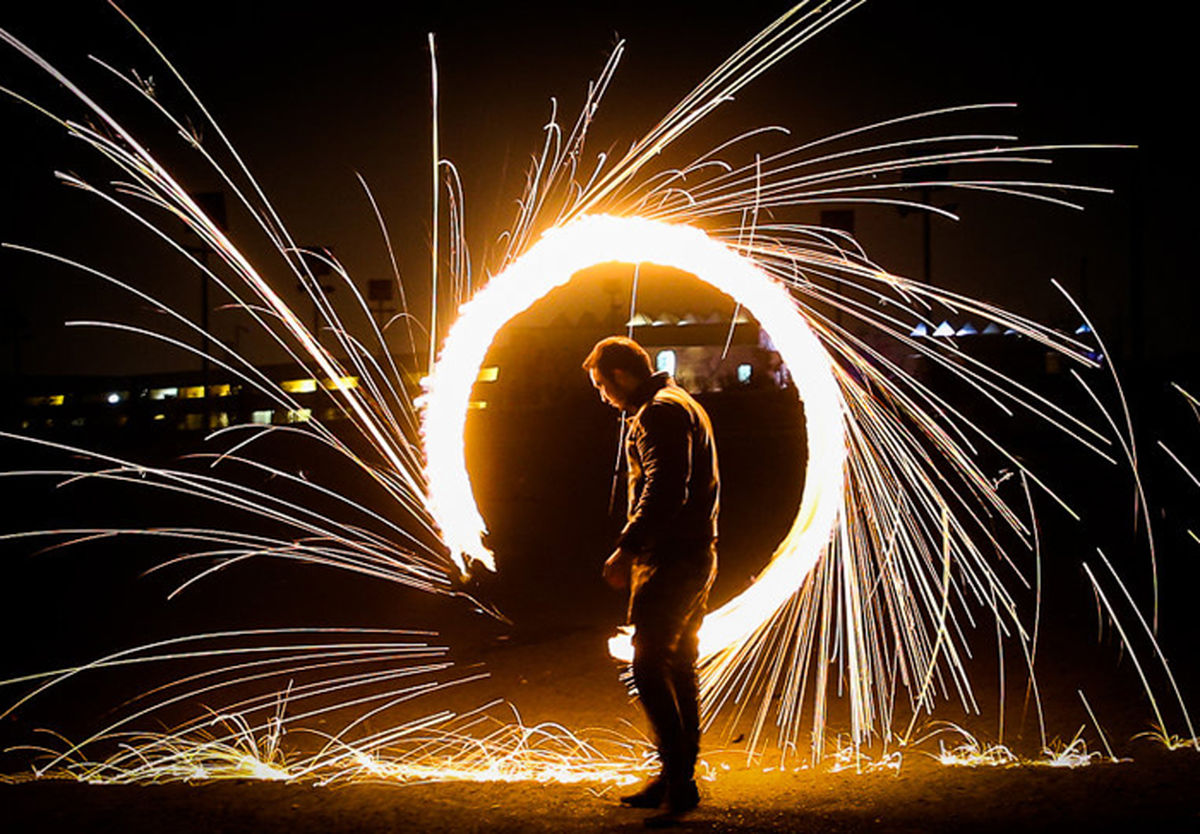
It is possible that Iranians, following their example, established ceremonies on this day to ward off bad luck. Given these considerations, it appears that Charshanbe Suri as we know it did not take place before Islam. However, since the tradition of lighting fires on rooftops persists in some Iranian regions, such as South Khorasan, it is evident that the roots of this celebration trace back to ancient Iran.
Evidence and indications also suggest that this celebration has a very ancient history, dating back to the pre-Zoroastrian era in Iran. In ancient Iran, there was no week, and the time for Charshanbe Suri was in the last 10 days of the year. It seems that in the early Islamic centuries, this celebration became fixed on the last Wednesday night of the year and was used to ward off bad luck and calamities.
The tradition of lighting fires on the rooftops, the final ceremony of the end-of-year rituals or the Gahanbar Pashangan, involves individuals called “Atash Afrouzan” going to cities and villages a few days before Nowruz as messengers of this celebration. These skilled women and men engaged in street performances, singing, and entertainment to bring joy to the people. Additionally, starting from a week before the arrival of the new year until the 14th day of Nowruz, simultaneous with the darkening of the sky, fires were lit in various parts of the city and village. This fire symbolized light, friendship, and affection, aiming to bring positive energy to people so they could overcome grief and melancholy.
On the night of Suri, they would light a large fire on most rooftops to seek warmth and ward off the cold. According to our ancestors, the fire and smoke rising from the rooftops, in addition to being delightful, guided the spirits of the departed towards their homes. Historical artifacts, such as the Chehelston Palace, also depict the observance of Charshanbe Suri. In the southern wing of this palace, an intriguing painting resembling a Charshanbe Suri-like ceremony catches the eye. This Safavid-era painting, supervised by Reza Abbasi, illustrates fire and a gathering of people around it.
Charshanbe Suri in Shahnameh
Shahnameh also reflects the traces of Charshanbe Suri. For instance, in the story of Rostam and Sohrab, a stargazer advises Bahram Chobin:
The stargazer told Bahram, “Strike your bow on Charshanbe;
If you turn from this, misfortune will come to you, all deeds will become malicious.”
In another part of Shahnameh, when Siavash passes through the fire to prove his innocence, some researchers consider this event as the starting point of Charshanbe Suri.
Siavash Passing Through the Fire
Additionally, Siavash, captivated by the love and temptation of Sudabeh, his stepmother, is accused unjustly. Upon learning of this, his father Kai Kavoos asks him to pass through seven tunnels to prove his innocence. In this way, Siavash emerged triumphant from the fire on the last Tuesday night, and Kai Kavoos declared a national celebration from Charshanbe to Friday, and people across the country engaged in festivities.
Since then, Iranians, on the Tuesday night each year, jump over the fire in memory of Siavash and his purity, celebrating this day.
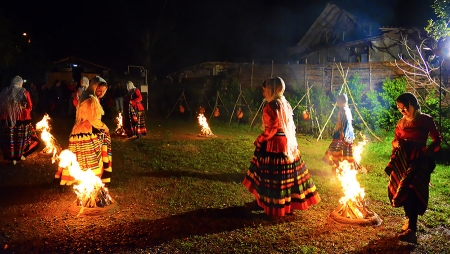
Philosophy of Charshanbe Suri
Charshanbe Suri is essentially a precursor to the celebrations of the Nowruz season, symbolizing the arrival of spring. The primary principle of this ancient ritual is lighting a large fire and jumping over it to cast away illnesses and troubles, receiving the redness, strength, and warmth from the fire as a gift. Actions such as burning esfand (wild rue), sweeping, Zajsuzi (a symbolic act to transfer the past year’s hardships to an earthenware jug and break it), casting ashes outside the house, and even smashing pottery were all measures aimed at dispelling calamities and eliminating the evil eye.
One of the philosophies behind holding this celebration and lighting fires is the desire to escape the cold and seek warmth. Aryans considered fire purifying and a means of cleansing themselves. Additionally, Iranians believed that during the last five days of the year and the first five days after the new year, the spirits of the deceased would come to inform their families of their well-being. It is said that this is essentially why the Charshanbe Suri ceremony took shape. On the first night of the last five nights of the year, people lit fires on their rooftops not only for a sacred purpose but also to guide the spirits of the departed towards their homes. The story did not end there, and people, with house shaking and wearing new clothes, prepared themselves for the new year, distancing themselves from enmities and negativity. Through these actions, they provided the conditions for the satisfaction of the departed spirits.
Charshanbe Suri Customs and Traditions
In the last days of the year, as people gear up for Nowruz and the New Year celebration, Charshanbe Suri ceremonies bring about an interesting and vibrant atmosphere in various parts of the country.
According to tradition, on Tuesday night, the younger generation visits the elders to spend the night together joyfully. A day or two before the event, people collect firewood or bushes, using rice straw in some cities like Gilan or date palm leaves in Khour. On Tuesday afternoon, these collected materials are arranged in open spaces such as courtyards, streets, or village squares, a few meters apart. As night falls, people set these piles ablaze. Gathered around the fire, people of all ages recite, “Your redness is mine, my paleness is yours,” and they leap over the flames, casting their ailments and sorrows into the fire, seeking health and joy in return. Additionally, phrases like “Go sorrow, come joy; go hardship, come prosperity!” and “O Tuesday night, O key to four gears, grant the servant’s wish!” are chanted while leaping over the fire, particularly in Tehran.
Fireworks are just a corner of this celebration; the essence lies in the togetherness and communal spirit of this ancient ceremony.
In some parts of Iran, they light these fires on rooftops, following the ancient tradition. After everyone in the house jumps over the fire, they let the fire extinguish on its own or use a pot of water to put it out. Subsequently, one family member collects the ashes and takes them outside. Interestingly, upon returning home, they knock on the door, leading to a playful exchange with the household: “Who is it?” “It’s me.” “Where are you coming from?” “From a wedding.” “What did you bring?” “Health.”
A ceremony known as “Darendez” or “Diarandaraj” is held by the Armenian community on February 14th (25th of Bahman), resembling Charshanbe Suri, including jumping over the fire.
Unfortunately, Charshanbe Suri has undergone changes in recent years, and now we witness the use of explosives and frightening sounds throughout the city. Apart from burning paper and waste instead of bushes and wood, causing extra trouble for cleaners, terrifying sounds of explosive materials create noise pollution and pose significant physical harm to people. This ancient ritual, which was once a source of family and community gathering, has now become a source of fear and terror, with consequences such as severe burns or even death.
According to research findings, all the rituals that Iranians once practiced, and some of them still do, were intertwined with the wisdom and beliefs of our ancestors. The belief in a higher power, the struggle against evil, and hope for a better life were ingrained in these practices. The violent behavior seen in society during Charshanbe Suri was not apparent in the background of any of these rituals.
In addition to lighting fires and leaping over them, various other rituals take place in different parts of Iran. Some families start house cleaning right on the day after Charshanbe Suri, while in other regions, such as Shiraz, people cook a special type of noodle soup on this day. In the following sections of this article, we will delve into some of the most important Charshanbe Suri rituals.
Koozeh Breaking
Breaking a koozeh (clay jug) is one of the intriguing and somewhat forgotten customs of Charshanbe Suri. After leaping over the fire, people proceed to break a koozeh. Apparently, there is a belief that by breaking the koozeh, misfortune and unhappiness within the household are eliminated. However, koozeh breaking comes with variations. For instance, in Tehran, people throw a few coins into the koozeh and then toss it from the rooftop to the alley. Until the time when there was a traditional fireplace in Tehran’s Arg Square, some individuals used to go there and drop a new koozeh from the top to the bottom, symbolizing the casting away of hardships and misfortunes for themselves and their families.
In Khorasan, they put a coin symbolizing poverty, some salt for bitterness, and a bit of coal for bad luck inside a clay koozeh. Each family member then spins the koozeh around their head, transferring any negativity to the koozeh. Finally, the last person throws the koozeh from the roof of the house to the alley, saying:
“I’ve poured the house’s pain and affliction into the alley.”
Meanwhile, in Arak and Aleshtar, they use barley grains in the koozeh for the breaking ceremony.
In some regions of southeast and east Iran, they often use old, unused koozehs instead of new ones. This might have hygiene roots, as ancient Iranians believed that clay containers should not stay in the house for more than a year. As the year approached its end, these clay vessels were broken on Charshanbe Suri. Since these vessels lacked glaze, making them uncleanable, breaking them was the only way to get rid of them. Additionally, this practice boosted the business of koozeh makers.
In certain areas, the koozeh breaking ceremony takes place in the evening of Charshanbe Suri. While breaking their old clay koozehs, families say:
“Go away, ill-fated Charshanbeh, so that you won’t come back. Go, and take away all the bad luck with you.”
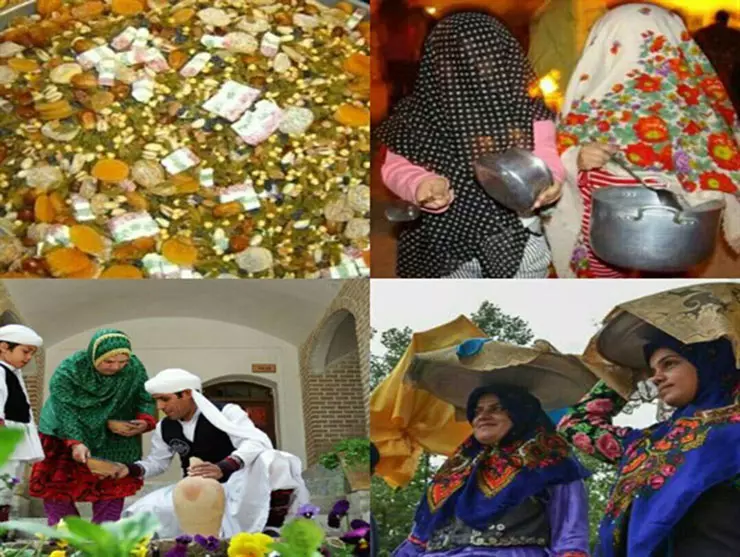
Spoon Beating
In the spoon beating ceremony, young girls and boys wear a veil on their heads to remain unrecognized. Later, they go to the houses of seven neighbors, beating spoons against bowls. Upon hearing the sound of spoon beating, the homeowner goes to the door, and the youngsters’ bowls are filled with nuts, chocolates, sweets, coins, or money. According to this tradition, those who receive gifts from homeowners will have their wishes fulfilled.
The roots of the spoon beating ritual likely come from the belief that the spirits of the deceased visit the houses of the living at the end of the year, seeking remembrance and blessings. According to Zoroastrianism, during the last five days of the year until the fifth day of Farvardin, Ohrmazd empties hell, allowing the spirits to be free for ten days. Instead of verbal communication, the spirits use bodily language, manifested in spoon beating.
Ear Sitting Fortune-Telling
Ear sitting fortune-telling is another forgotten custom of Charshanbe Suri. People, especially young girls, sit by the roadside on Tuesday night and listen to passersby. By interpreting the words they hear, they deduce the outcome of their intentions. If they hear happy and positive words, they believe their wishes will come true. Conversely, hearing bitter and sorrowful words leads them to the conclusion that they won’t achieve their desires in the new year.
Shawl Throwing
The shawl throwing ritual is another overlooked tradition. Although it is still preserved in some parts of Iran, such as Hamedan and Zanjan.
This ceremony involves young people tying several silk and satin handkerchiefs together to create a colorful rope. They throw one end of this rope from the chimney of their home into the neighbors’ yards. With a few loud coughs, they announce their presence to the homeowner. Upon seeing the colorful rope, the homeowner throws prepared gifts into the shawl, ties a knot, and gently pulls the rope up. The gift signifies a form of fortune-telling for the shawl owner. For instance, bread represents sustenance, sweets symbolize happiness and sweetness, pomegranate indicates blessings and a large number of children, walnuts symbolize longevity, and a silver coin represents good luck or an intention for marriage.
Fireworks Display
The fireworks display is considered one of the captivating customs during the celebration of Charshanbe Suri, which has taken an extreme form in recent times, overshadowing other traditional programs of the Tuesday night festivities.
It is not entirely clear when fireworks (firecrackers, flares, etc.) became part of Charshanbe Suri, but its traces can be found in the Qajar era. During that period, fireworks were used in various festivals and celebrations as a form of royal and public entertainment. Mentions of fireworks in the travelogues of European tourists who visited Tehran during the Qajar era serve as evidence of this claim.
Cracking the Nut Mix for Problem-Solving
In the past, it was a custom for relatives and acquaintances to gather, and the last remaining winter nuts, such as pumpkin seeds, watermelon seeds, pistachios, hazelnuts, wheat, almonds, and melon seeds, were roasted on the fire. After blessing them with salt, people would eat these nuts together.
Our ancestors believed that consuming this mixture would make people more compassionate and keep evil away from them. From a medical perspective, the various vitamins and nutrients in these nuts were believed to help ward off depression and illness.
Water Splashing and Water Play
In some rural areas of Iran, people would gather their families on the evening of the last Wednesday of the year without speaking to others. They would take their jugs or pitchers towards a river, stream, or spring. After filling the container with water, they returned home and splashed the water on the doors and walls of their homes.
Sometimes, they would also splash water on anyone they encountered along the way, wishing them a new year filled with health and joy. Some individuals even entered springs or rivers and poured water with a wooden ladle over the people standing nearby, aiming to purify them.
Fortune-Opening Ritual
In the past, young girls engaged in a unique ceremony called “fortune-opening” on Charshanbe Suri. In one of these rituals, they would buy some herbs and seven walnuts from a herbalist facing Mecca. They would then head to a potter’s wheel to ride it and spin the wheel seven times while breaking a walnut in each round. This was done with the recitation of specific poems to open their fortunes. Finally, they gave money and herbs to the potter and returned home.
One specific ritual in Tehran was the “pearl ball.” In a square in Tehran called Arg, women and girls believed that passing under a hanging ball would open doors for them and bring good luck. They thought that by passing under the ball, their wishes would come true.
Fortune-Telling with Balloons
Fortune-telling with balloons is considered one of the sweetest ancient traditions of Charshanbe Suri, primarily revolving around play and amusement. Balloons were small, wide-mouthed jars used to store pickles, jams, spices, etc. Women and young girls would gather together, and each person would throw something into this jar. In addition, they would write poems on paper and put them inside the jar. Then, one of them would first retrieve a piece of paper from the balloon and read the poem on it. Subsequently, they would pull out an item from inside the balloon. The poem that was read belonged to the owner of that item, describing their current state and fortune.
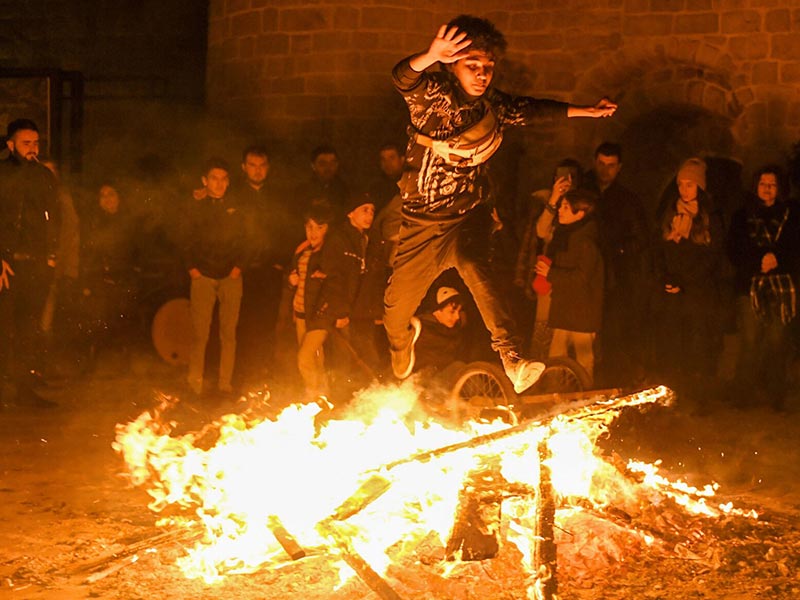
Balloon of Wishes
One of the customs that has recently found its place in Charshanbe Suri ceremonies is sending balloons of wishes into the sky, which does not have roots in our culture. Individuals, by lighting these balloons and sending them into the sky, make wishes.
Charshanbe Suri in Some Regions of Iran
Tehran:
In the past, people in Tehran would bring dried shrubs from the surrounding deserts and, after sunset, create a fire using these shrubs and old wooden items. Everyone would jump over the fire while reciting the phrase, “Your redness is from me, my yellowness is from you.” Although nowadays we mostly witness homemade firecrackers and fireworks crafted by teenagers, which have diminished the charm and joy of this night.
Another old tradition in Tehran was emptying the water tank. A few days before Charshanbe Suri, women would wash dirty dishes and items like clothes, spread them on a wide cloth, and tie them together for stronger family bonds. Later, they would empty the tank and replace the water.
Shiraz:
In addition to lighting fires, Shiraz had other traditions like fortune-telling, burning esfand (wild rue), and circling salt around one’s head while reciting special verses. According to an ancient custom, young girls would tie a seven-colored silk ribbon around their waists, and the next morning, they would ask an immature child to untie the silk, symbolizing the opening of their destiny. Young girls would also go to a place called “House of Seyed Abotarab” in the Glassblower Alley, cook halva under its ancient tree, and distribute it among the needy. Shirazis, having a special affinity for Hafez, read his poems during Charshanbe Suri night, known as “Fal Doreh.”
Kurdistan:
On the last day of the year, if the weather allowed, people in Kurdistan would go to the plains and light a fire at the highest point of the mountain. They would also ignite a large fire in a suitable location and engage in local dances and jumping around the fire. Kurdish dance is an integral part of Charshanbe Suri ceremonies.
Women in the village would cut a few strands of their children’s hair and throw them away to prevent old-year problems from transferring to the new year. According to a local tradition, people used to carry four small stones and throw them over their shoulders while walking home.
Isfahan:
Lighting fires and jumping over them is common in Isfahan, although forgotten customs like breaking pots, fortune-telling, untying knots, etc., were prevalent among the locals. On the eve of the last Wednesday of the year, they would set fire to a shrub and pour a pot of water with a few grains of esfand on it to dispel misfortune in the new year.
Interesting to note is the “Ajeel-e Moshtalagh” tradition in Isfahan, consisting of seven nuts or dried fruits like oleaster, pistachio, almond, raisin, fig, walnut, and date. Sometimes small pieces of herbs and coconut were also included in this Ajeel mixture.
Tabriz:
In the past, people in Tabriz would go to the Thursday market with their family members on the eve of Charshanbe Suri to buy sweets, dried fruits, and Ajeel, known as “Chaharshanbe Yemishi.” Another old Tabrizi tradition during Charshanbe Suri (last Wednesday) was sending “Charshanbe Liq” to the newlywed groom, including Charshanbe Suri Ajeel, cloth, and a shirt.
Setting fire and jumping over it was another ancient tradition in this region, where people sang songs while jumping, such as:
“Atil Matil, Charshanbe, Bakhtiye Man, Achil Charshanbe.”
People also stood in line for fortune-telling, revealing their family matters. Depending on the tone and words, fortunes were interpreted as either good or bad. That’s why people refrained from speaking ill, behaved well, and engaged in conversation through songs.
Khuzestan:
During the sunset on the last Tuesday of the year in Khuzestan, it was customary for people to gather shrubs from the field to create a fire. Similar to other cities, they would set fire to them, and men and women would jump over the flames while reciting: “Your redness is from me, my yellowness is from you.” In cities like Ahvaz, there was a tradition called “Qashoq Zani,” where people would go to their neighbors’ houses after the fire-lighting ceremony to receive sweets or Ajeel.
Yazd:
In Yazd, both Zoroastrians and Muslims participate in the Charshanbe Suri celebration. People collect kindling in open spaces, ignite them at sunset on Tuesday, and jump over the fire. They also throw esfand and kondeh into the fire while reciting specific verses. A common song during this ritual is:
“Zardeye Man Az To, Sorqeye To Az Man.”
People in Yazd have various customs, such as burying potatoes in the ashes and joyfully eating them together. Other traditions include breaking a pot, fortune-telling with a pot, and distributing Ajeel for problem-solving (Lark).
Zanjan
Bonfire lighting, gunshot, firecrackers, etc., are among the traditions of the people of Zanjan on the eve of the last Wednesday of the year. Interestingly, in the past, the people of this region used to celebrate every Wednesday of the Esfand month and from the first Wednesday to the last Wednesday of each month, they were called “Yekkeh Chaharshanbe” (First Wednesday), “Qoodoq Chaharshanbe” (Second Wednesday), “Koolleh Chaharshanbe” (Third Wednesday), and “Akher Chaharshanbe” (Last Wednesday), respectively. According to the tradition, on the first Wednesday of Esfand, they would go to the rooftop and pour lentils, wheat, or chickpeas as a sign of prosperity in front of the water fountains. Then, the family members would gather around a table of fruits and nuts and spend a joyful night.
Additionally, after lighting the fire in the alleys or on the rooftops, young people, while jumping over it, would sing:
Atel Matel Chaharshanbe, Aina Takin Bakhtim A’chil Chaharshanbe
One of the traditions of the people in Zanjan was related to the neighborhood of “Koocheh Khan Nazem Darvaze Ark,” where a large fire was lit after the first dead-end, and the locals gathered around it. If one of the neighbors had lost a close relative that year, the locals would invite them to join in the joy of the last Wednesday of the year while preserving the sanctity of their grief.
The custom of “Shal Salama” is still practiced in some areas of Zanjan. Women who wished to become mothers would throw a matchstick into a basin; if the matchstick landed inside, they interpreted it as a sign that they would become pregnant.
“Shal Salama” or “Shal Atma,” which is still prevalent in most rural areas of Zanjan, is a form of scarf throwing. Young people would hang a handkerchief from the rooftops of their neighbors, and the homeowner, by saying “Chek! Allah Motlabin Varisin” meaning “Pull! May God grant your wish,” would fill their handkerchief with nuts and fruits.
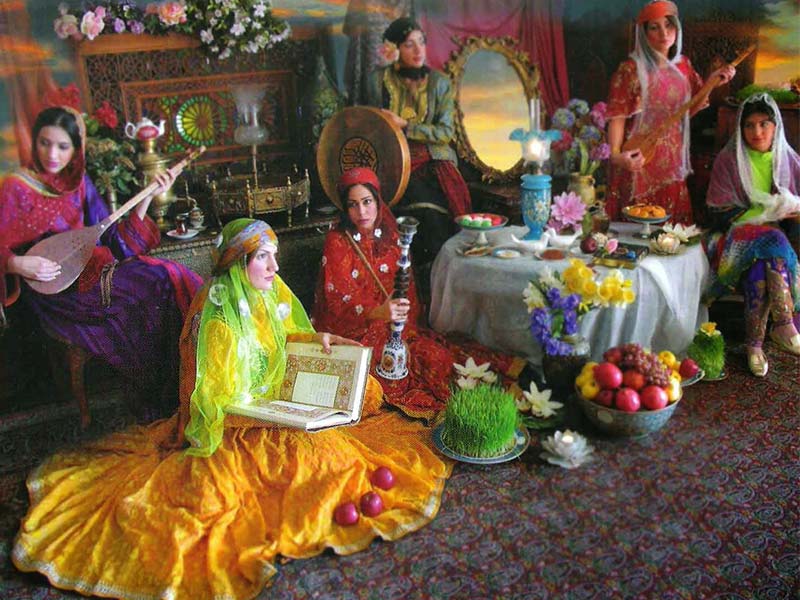
Sistan and Baluchestan
The people of Sistan and Baluchestan, following an ancient tradition, light firewood and bushes at sunset and jump over the fire; although, in areas with palm groves, they use dried date palm leaves for bonfire lighting.
In the past, household members and relatives would gather, and the last grains of vegetables from watermelon seeds to pumpkin seeds, pistachios, almonds, walnuts, etc., were roasted over the fire and consumed to celebrate the arrival of spring.
An old custom among the people of Sistan and Baluchestan is to gather unripe wheat clusters and cook them over the fire on the last Wednesday night, known as “Palo,” symbolizing the beginning of spring. In this region, they also prepare a special soup, mainly for the fulfillment of wishes and the healing of patients.
Gilan
The people of Gilan, in addition to burning esfand and kondor, light candles and make their own rosewater on the night of Wednesday. Bonfire lighting is also prevalent in this region, although the people of Gilan scatter the ashes of the fire on tree roots in the morning on Wednesday to make them fertile.
Different regions of Gilan celebrate Chaharshanbe Souri in various ways. In the past, this ceremony involved shooting arrows and fireworks, and sometimes one person would go to a tree with an axe that wasn’t working. When others guaranteed that next year he would use it, the person would abandon the axe.
Interestingly, in the Masal and Talesh region, Chaharshanbe Souri is called “Kooli Kooli Chaharshanbe,” where they put bundles of straw toward the Qibla and light them on fire. People then jump over the fire, and some perform gunfire for joy. Later, they gather around a dinner table with seven types of stews and edibles.
In Bandar Anzali, while jumping over the fire, they say:
Gool Gool Chaharshanbe, Be Hagh Panjshanbe, Nakbat Beshe, Shokat Biye, Zardi Beshe, Sorkhi Biye
People in Astara also collect rice stalks (rice straw) in groups of five, seven to nine, and after lighting them on fire, they have the larger ones jump over the fire first, followed by the smaller ones.
Wednesday Feast Foods and Snacks
Abdoorda Ash, similar to regular Reshteh Ash, where seven types of legumes are used, is often cooked and distributed by families with an ill member on the eve of the last Wednesday of the year to fulfill their needs and improve the health of the patient.
Among the famous foods of this celebration is the Seven Nuts or Chaharshanbe Souri Ajil, which in the past played the role of problem-solving, and people would buy Ajil facing the Qibla from stores and distribute it among the community for their needs. This Ajil includes walnuts, raisins, dried mulberries, pistachios, almonds, peanuts, hazelnuts, and more.
Chaharshanbe Souri Ajil in different regions of Iran consists of various items. For example, in West Azerbaijan province, figs, chickpeas, fruit juice, dates, oleaster, rice, peach leaves, salt-free seeds, and peeled wheat are part of the Ajil.
In some parts of Khorasan province, they cook four types of Pilaf, including Reshteh Pilaf, Zereshk Pilaf, Adas Pilaf, and Mash Pilaf, and often share them among relatives and the less fortunate. Interestingly, the Khorasani Ajil has no salt because salt is considered a sign of bad luck.
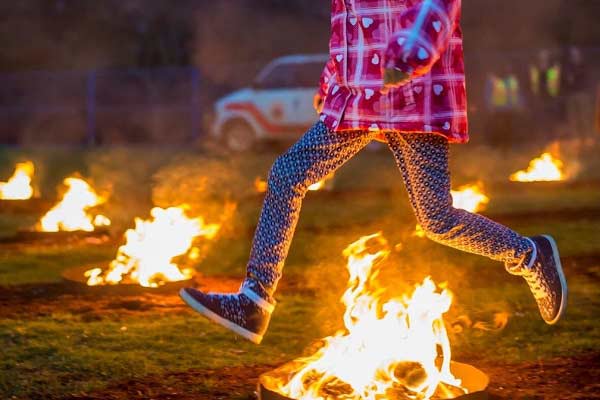
One of the delicious dishes in Zanjan on the night of Chaharshanbe Souri is “Shesh-andaz,” prepared with a combination of grape syrup, oil, onions, dates, walnuts, raisins, and eggs. It is served with Polo Zafaran or Reshteh Polo.
The Gilaks prepare “Torsh-e Tare” soup for this celebration, and they enjoy it with kutteh and yogurt. In Mazandaran, various Ash soups, such as Ash-e Haft Tashi, are cooked, using seven types of pickles, greens, and legumes.
If you celebrate Chaharshanbe Souri in a unique and special way in your region, share it with our users below this article.
FAQs
What is the meaning of Chaharshanbe Souri?
Some researchers consider the word “Souri” to mean “celebration,” while others believe it is derived from the Pahlavi word “Sourik,” meaning “red,” symbolizing the redness of fire and good health.
On which day is Chaharshanbe Souri celebrated?
Chaharshanbe Souri is one of the Iranian celebrations held on the eve of the last Tuesday of the year with specific customs and traditions.
What is the reason for lighting a fire on Chaharshanbe Souri?
Lighting a large fire and jumping over it allows people to cast away their illnesses and problems into the fire and receive warmth, energy, and vitality from the flames.
What are the rituals of Chaharshanbe Souri?
Lighting a fire, spoon banging, pot breaking, ear reading, and…




